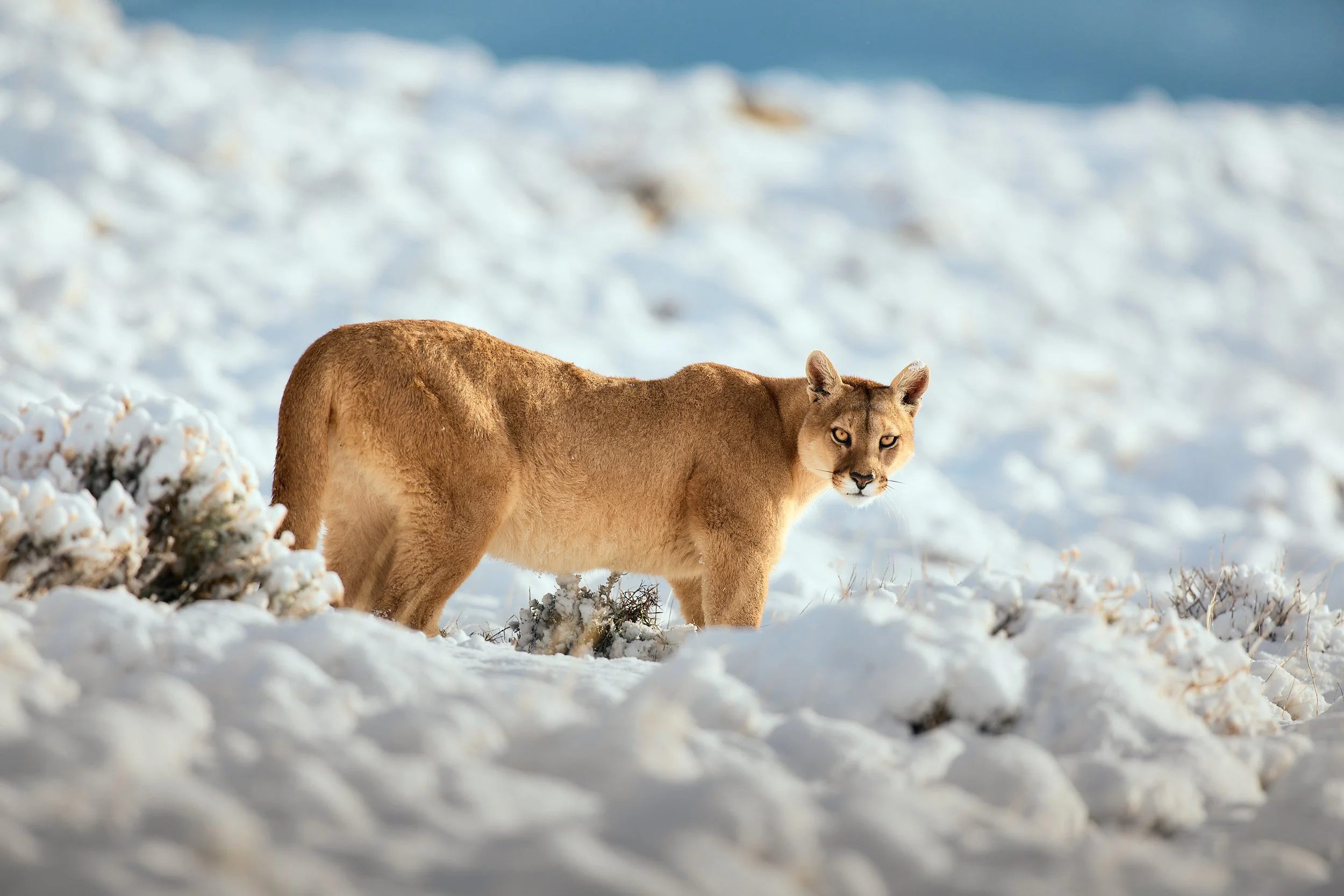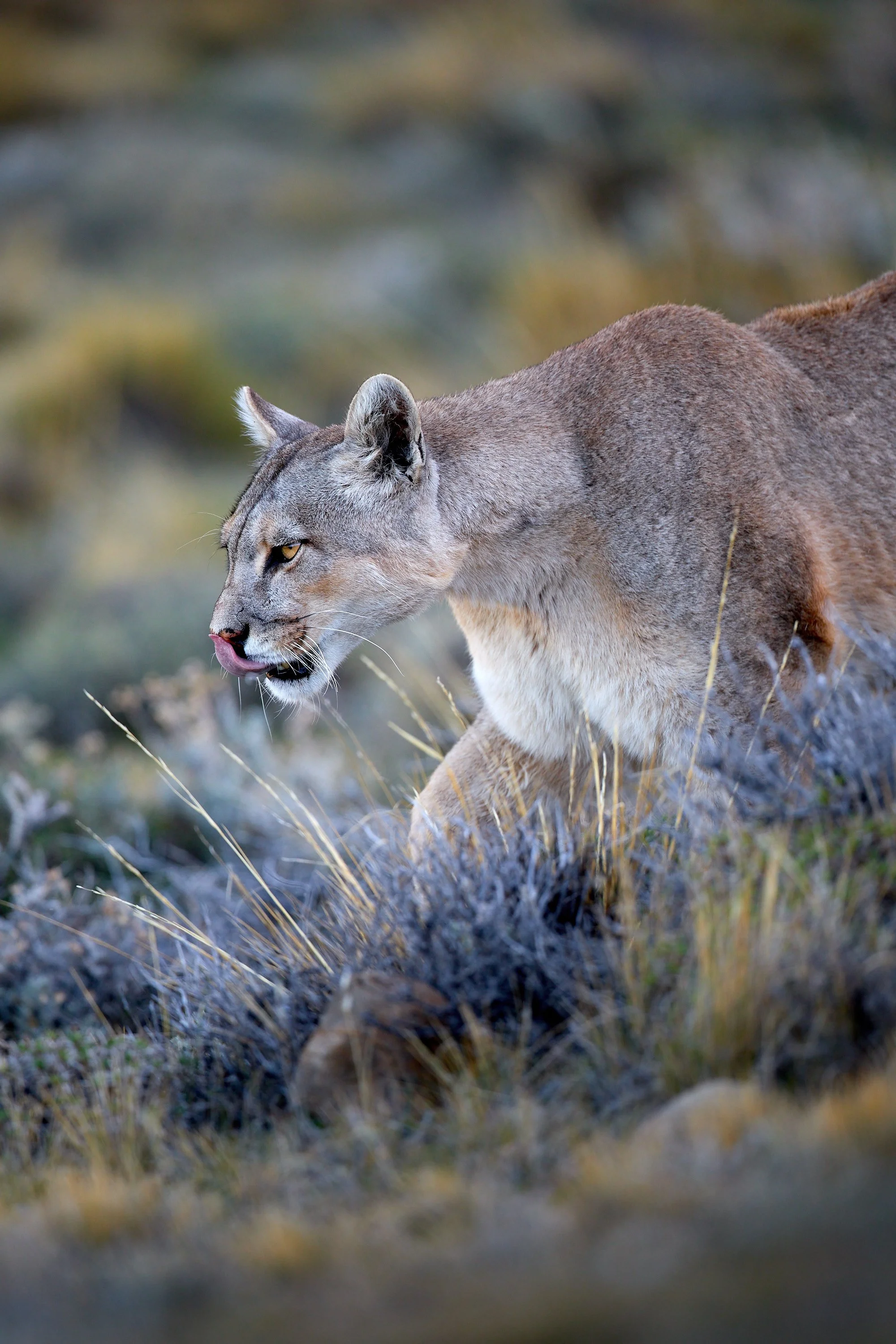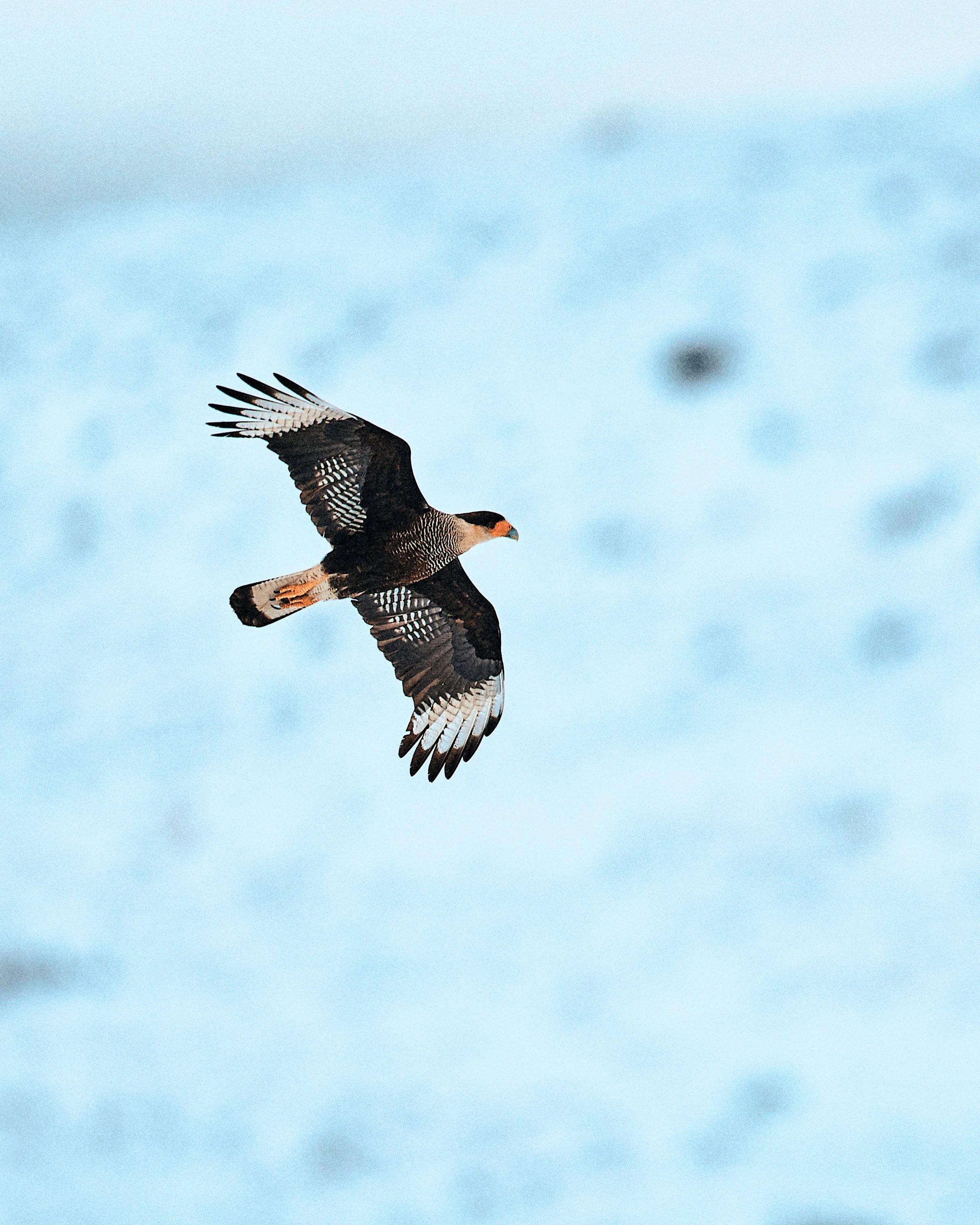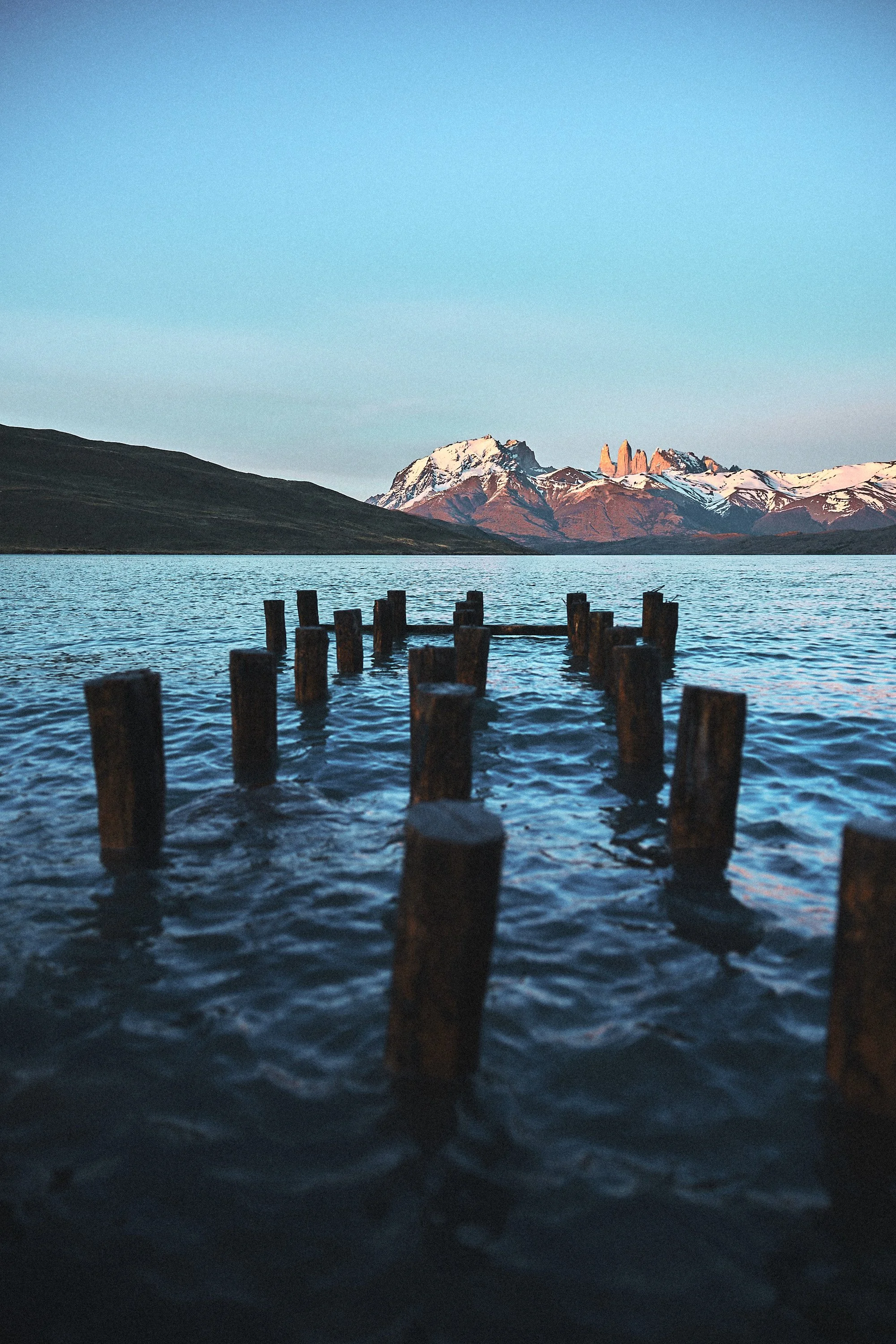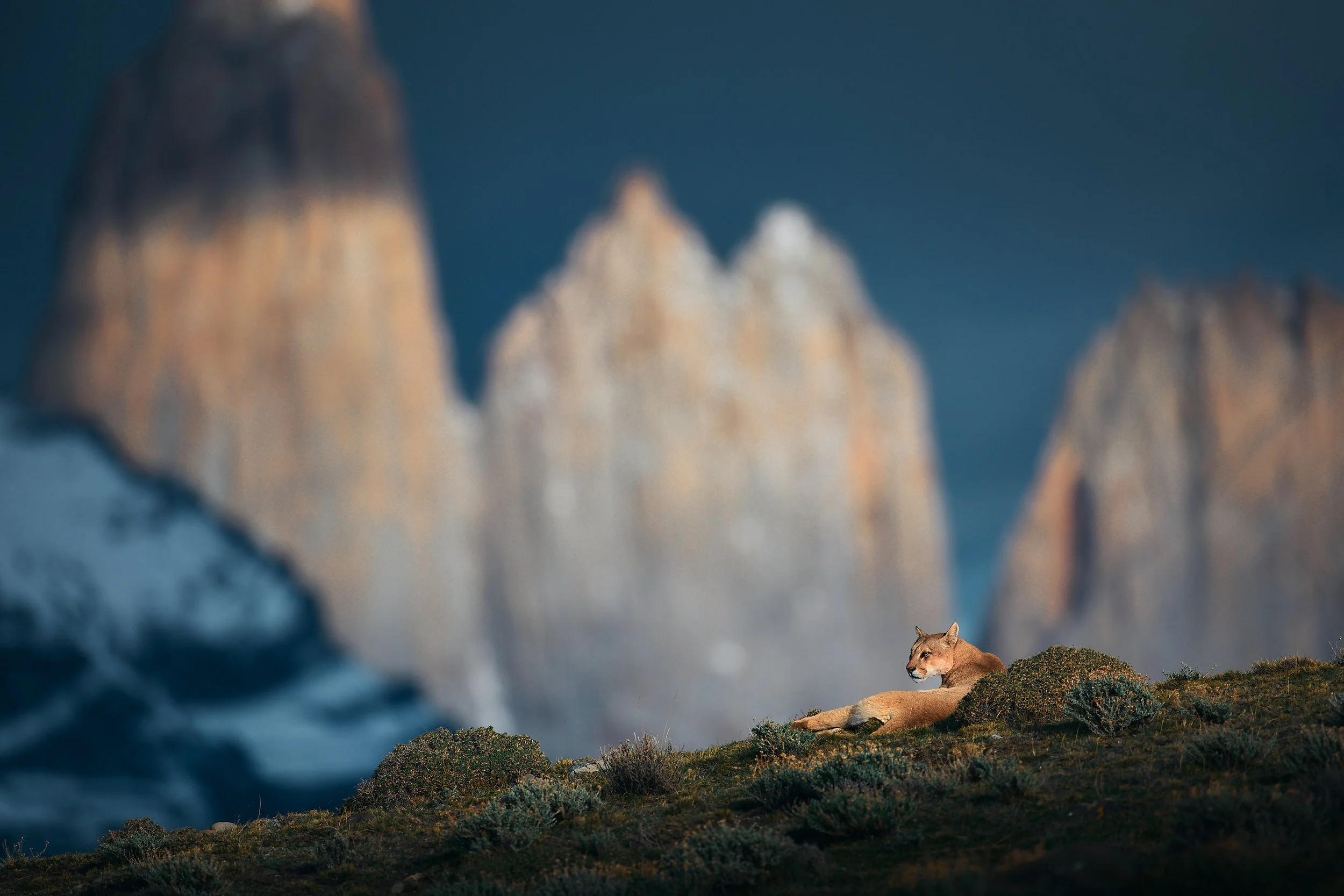Pumas of Patagonia
March 2027
Explore Patagonia’s wild side on a photography trip dedicated to tracking - and photographing - pumas in their natural habitat.
Trip highlights
Private Access & Prime Puma Territory
We will have accesso to a private estancia bordering Torres del Paine National Park, one of the best areas in the world to track and photograph wild pumas. Thanks to private land access and expert trackers, we’ll explore remote valleys where chances of puma sightings are much higher than in the National Park - where off-road driving and walking is not allowed - offering intimate and respectful encounters in breathtaking surroundings.
Small Group, Big Opportunities
With only 5 guests, Paolo as your personal guide and a professional local tracker, you’ll enjoy maximum shooting flexibility, personalized instruction and prime positioning during each sighting. Whether you’re perfecting compositions, working with low light or experimenting with storytelling, you’ll get hands-on support every step of the way.
Beyond the Cats: Wild Patagonia Landscapes
This experience also includes a full day dedicated to the iconic landscapes of Torres del Paine National Park — with towering granite peaks, vivid glacial lakes, and herds of guanacos set against dramatic skies. A chance to slow down, shift your focus, and create powerful scenic imagery to round out your portfolio.
5 full days of expert-led tracking in a private reserve — only 5 seats available.
Priority list subscribers will receive early access and a private invitation when bookings open.
When?
March 2027, dates TBA
Group Size
Max 5 people
Price
10.900€
Experience
PHYSICAL DIFFICULTY
This workshop is open to photographers of all levels, but is better suited to those with a basic understanding of camera settings like shutter speed, aperture, and ISO. Since wildlife encounters can happen fast, we recommend guests be familiar with operating their gear confidently in the field.
If you’re not quite there yet, don’t worry — all participants will receive access to pre-trip learning materials and the option for personal video calls with Paolo in the weeks leading up to departure. This ensures everyone arrives prepared and ready to make the most of every photographic opportunity.
This tour is designed to be accessible for anyone in reasonable physical condition. Most of the tracking is done using 4x4 vehicles, but once pumas are located, we’ll approach them on foot. Participants should be comfortable walking up to 2 km with moderate elevation gain (max 100m), often over uneven terrain and in variable weather.
In March, Patagonian weather is famously unpredictable: you may experience sunshine, wind, rain and even snow in a single day. Temperatures typically range from 5–18°C (41–65°F), with early mornings and evenings being colder and very windy at times. Good waterproof gear, sturdy boots, and a layered clothing system are essential. Our pace will remain flexible, with plenty of rest and time to enjoy the wild beauty of Torres del Paine.
A female puma photographed in front of Torres del Paine at sunset.
What makes it special?
Built on First-Hand Experience
Paolo first explored Patagonia as a mountaineer, photographing its dramatic peaks during his early years as an alpinism photographer. He later returned with a new focus, tracking and photographing wild pumas in the same remote valleys featured in this workshop. This deep connection to both the landscape and its wildlife ensures you’ll be guided with insight, precision, and purpose at every step.
On-Foot Puma Photography in Untouched Terrain
This is not a traditional safari. Our group will access a private area within prime puma territory, where we’ll photograph these elusive cats on foot, in their natural environment. Patience and silence are key — sightings happen on the animals’ terms, and that’s exactly what makes them unforgettable. This is an intimate and immersive experience, far from crowds and fences.
Guided Learning from Start to Finish
Your growth as a photographer is at the heart of this experience. Ahead of the trip, you’ll receive learning resources and a personal video call with Paolo to get fully prepared for the field. During the tour, you’ll benefit from real-time coaching tailored to your style and goals. And after the adventure, you’ll receive a 1:1 online session to review your portfolio, refine your post-processing, and make the most of the images you’ve captured.
Ethical Tracking with Local Experts
We’ll be joined by expert local trackers who work on-site year-round, observing puma movements daily from sunrise to sunset. They rely on field presence, signs and behavior patterns to guide us — ensuring that every encounter is built on awareness and respect. This approach allows for genuine wildlife moments, free from disturbance or pressure.
What Puma Tracking in Patagonia Really Feels Like
Go behind the scenes of Paolo’s experience in the field — from golden sunrises to silent, unforgettable encounters with wild pumas.
What will I learn?
Understanding natural light and choosing the best exposure
Learn how to optimize your camera settings for different scenarios, whether it’s low light or super fast action
How to frame natural scenes, from wide landscapes to tight wildlife portraits, to create balance and harmony in your images
How to use shutter speed and aperture settings to create unique images
What lens to choose based on your vision
All the basics to capture images of animals in a truly wild landscape
Post-production basics, how to organize your files and backup strategies to make sure you won't lose your precious files
Our itinerary
Early starts, long tracking walks, and moments of stillness that lead to powerful encounters. This itinerary is designed to maximize photographic opportunities while allowing time to rest, reset, and fully immerse yourself in the silence and scale of Torres del Paine’s unique wilderness.
Day 1 – Arrival & First Sunset
You’ll arrive at Punta Arenas or Puerto Natales Airport, where a private transfer will take you to our base near Torres del Paine. As we travel through the Patagonian steppe, keep your eyes open for guanacos and the striking horizon of snow-capped peaks.
Once settled at our accommodation, we’ll gather for a welcome briefing and meet our local tracking team. This is your chance to settle in, ask questions, and prepare for the days ahead.
Day 2 – Landscape Photography in Torres del Paine
Our first full day is dedicated to capturing the legendary landscapes of Torres del Paine National Park.
This is your chance to slow down, tune into the elements, and compose images that combine grand scenery with small natural details. We’ll work on long exposure techniques, storytelling through scale and finding your visual voice in one of the most photogenic places on Earth.
Days 3 to 7 – Sunrise to Stars
These five days are fully dedicated to tracking and photographing wild pumas on foot. Each morning begins before sunrise, as our trackers — already out in the field — guide us toward promising locations based on the latest activity.
We’ll hike short distances across private land to reach shooting positions, always maintaining a respectful and ethical approach. Encounters may be close and intense or distant and quiet — either way, they’re authentic moments shaped by patience and presence.
Afternoons are flexible: we may rest, review images, or return to the field depending on weather, light, and movement patterns.
Day 7 – Final Sunrise & Departure
On our last morning, we’ll head out for a final sunrise photography session, soaking in the quiet beauty of the Patagonian steppe one last time. After returning to camp for breakfast and a heartfelt goodbye, we’ll begin our transfer back to Puerto Natales or Punta Arenas for your onward journey.
5 full days of expert-led tracking in a private reserve — only 5 seats available.
Priority list subscribers will receive early access and a private invitation when bookings open.
-
Full photography support throughout the trip — from pre-trip material and a personal video call, to daily field guidance and a 1:1 post-trip editing session with Paolo Sartori
5 full days of puma tracking on foot with professional local trackers who work year-round in the area and know the cats intimately
1 full day of landscape photography inside Torres del Paine National Park, exploring iconic locations with an EcoCamp guide during the best light
7 nights accommodation in Suite Domes at EcoCamp Patagonia or equivalent eco-style lodge, immersed in nature with all essential comforts
Double occupancy (shared rooms unless single supplement is requested and confirmed at the time of deposit)
All meals included: breakfast, lunch/box lunch and dinner from arrival to departure
Ground transport from Puerto Natales or Punta Arenas to our base near Torres del Paine and back
Private access to tracking areas on private land, ensuring ethical and intimate encounters
All tourism and park entry fees
Plenty of time for Q&A and one-on-one learning, both in the field and during downtime
Access to a private WhatsApp group for planning, support, and sharing with Paolo and fellow participants before and after the trip
-
International and domestic airfare to and from Puerto Natales or Punta Arenas, Chile
(We recommend arriving via Santiago, with a domestic flight connection to southern Patagonia)
Mealtime drinks, including soft drinks, wines, and alcoholic beverages
Snacks and drinks outside scheduled meals
Single room supplement (available upon request and subject to availability at time of booking)
Tips for local trackers, camp staff, and transfer drivers
Any personal purchases, including souvenirs, laundry, or additional services not listed in the itinerary
Credit card or international transfer surcharges where applicable
Travel insurance, which is mandatory and must include medical evacuation and trip cancellation coverage
-
The workshop is limited to 5 seats. Apply via the button at the end of this page. If there is still a spot available, you will be given instructions to make your deposit to secure your spot.
-
The price of the trip is 10.900 €.
A deposit of 2.440 € will be due to confirm the booking.
The remainder will be due 90 days before the trip departs.
-
To reserve your spot we do require a 2.440€ deposit. That deposit is only refundable for 48 hours after booking.
Once you pay for the rest of your trip you can receive the following refunds on the rest of the trip (deposits not included):
More than 90 days before the trip = 100% refund.
Between 90 and 60 days before the trip = 50% refund.
Less than 60 days before trip departure = 0% refund.
We highly recommend trip insurance.
We may cancel a trip prior to the start date for reasons including (but not limited to) insufficient participation, weather conditions, or other instances that may impede trip operations. In this case, you will receive a refund for funds paid towards the trip cost. You will not receive any refund for hotels, flights, or transportation you booked before or after the trip.
A legal language version of our trip cancellation is this...
We reserve the right to cancel any trip, at any time, prior to the scheduled departure date for any reason whatsoever, including without limitation, insufficient participation, local weather conditions or logistical problems that, in our sole judgment, may impede trip operations. In the event we cancel your trip for any reason whatsoever other than a force majeure event, your sole and exclusive remedy shall be the refund of all payments we received from you as of the date of cancellation. The payment of the refund shall release us from any and all other or further liability in any way related to such cancellation. We may make payments to our suppliers (permits, transportation companies, etc.) far in advance of the scheduled trip departure date. Accordingly, if a trip is cancelled due to a force majeure event (e.g. war, labor strikes, earthquake, flooding or any other cause beyond our control), we will undertake commercially reasonable efforts to promptly refund the portion of any amounts paid by you that have, in turn, not already been advanced to suppliers. In addition, we will use commercially reasonable efforts to recover and refund to you the balance of your payment amounts that were advanced to suppliers, less our expenses, if any, of such recovery, as promptly as possible. However, we do not guarantee you recovery of any portion of advance payments made to our suppliers. We are not responsible for, and you hereby release and forever discharge us from, any expense or cost incurred by you in preparing for or arising or resulting from a cancelled trip. If you cancel your trip, we will refund your payment as follows: (a) cancellation 90 days or more prior to trip departure – 100% of your payment will be refunded, with the exception of the deposit amount; (b) cancellation between 90 - 60 days prior to trip departure - 50% of your payment will be refunded, with the exception of the deposit amount; or (c) cancellation less than 60 days prior to departure, or during trip – no refund will be made.
Camera Equipment
This workshop is designed to help you build a powerful and diverse portfolio of wildlife images — from tight portraits of pumas to atmospheric scenes that place the animal within the vast Patagonian landscape. Unlike traditional safaris, this experience is conducted entirely on foot, often with sightings across open terrain and variable distances. Here’s how to prepare your gear.
Camera Bodies
For photographing pumas, birds, guanacos, and other wildlife, the ideal setup is a 600mm focal length on full-frame, with the option to extend reach using a 1.4x teleconverter. Here’s a breakdown:
Primary lens:
A zoom like 200–600mm / 200–500mm / 100–500mm is ideal for both reach and flexibility. If you own a super-telephoto prime (ideally 600mm f/4) make sure to bring it along.
Teleconverters:
A 1.4x teleconverter is highly recommended for additional reach, especially in vast open areas. Only use a 2x if you’re familiar with its limitations.
Secondary lens:
If you use a prime super telephoto, a shorter zoom like a 70–200mm or 100–400mm is extremely useful for environmental portraits, landscape-wildlife blends, and closer encounters.
Minimum recommendation:
Aim to cover 100mm to 600mm, with an option to extend past 800mm with a TC.
Lenses for Close Encounters
You’ll also have dedicated time for landscape photography inside Torres del Paine National Park — a unique chance to capture some of the world’s most iconic peaks and lakes.
A wide-angle to mid range zoom (e.g. 16–35mm or 24–70mm) will be your go-to for grand vistas, skies, and intimate landscape details.
Other Essentials
Extra memory cards and batteries – Expect to shoot several thousand images per day during active sightings.
Laptop + external SSD – For daily backups and image review. Paolo will guide you through safe workflow and storage practices throughout the tour.
Sturdy camera bag or backpack – Ideally something that fits under your seat and keeps your gear protected and accessible.
Camera cleaning gear – Dry season conditions are typically clear, but dust is everywhere. A battery powered blower, a brush and a lens/sensor cleaning kit will be essential to ensure you’ll keep shooting through the trip.
Solid tripod capable of holding your telephoto lens – mandatory for landscape photography, and highly recommended for wildlife so that you can frame your shot and then wait for the right moment without having the weight of your gear on your arms. Choose something stable and light enough to carry during short hikes.
Need Gear Advice?
If you’re unsure what to bring or are thinking about renting a lens, Paolo will be happy to give tailored advice based on your experience level and creative goals. Don’t hesitate to get in touch before the trip—we’re here to help you arrive prepared and confident.
YOU WILL RECEIVE A MORE DETAILED INFORMATION DOCUMENT WITH ALL THE INFOS ABOUT WHAT TO PACK 90 DAYS BEFORE YOUR TRIP. THE DOCUMENT WILL INCLUDE SPECIFICS OF WHEN AND WHERE TO MEET, GEAR AND CLOTHING RECOMMENDATIONS AND ALL THE VARIOUS INFORMATIONS YOU MIGHT NEED.
Getting there
We will pick you up either in Puerto Natales (PNT) or Punta Arenas (PUQ) on Day 1 of the trip, depending on your arrival preference. From there, we’ll transfer you to our base near Torres del Paine — where your Patagonian photography adventure begins.
The most straightforward international route is to fly into Santiago de Chile (SCL), then connect via a domestic flight to either Puerto Natales or Punta Arenas.
Puerto Natales (PNT) is the closest airport to our base and offers a shorter transfer time. Flights to PNT are seasonal and less frequent, so booking early is recommended.
Punta Arenas (PUQ) has more frequent daily connections from Santiago and may be the more flexible choice for international travelers.
🚐 Transfer Times to Our Base
From Puerto Natales: ~2.5 to 3 hours by private vehicle
From Punta Arenas: ~5 to 6 hours by private vehicle (with lunch stop in Puerto Natales)
Both routes are scenic, with expansive steppe landscapes, guanacos, and possible condor sightings along the way.
🛫 Booking Tips
If you’re flying from Europe or North America, we recommend booking your journey to Puerto Natales or Punta Arenas on a single ticket when possible. Some airlines and travel agencies offer through-tickets via Santiago, which simplifies connections and offers better protection in case of delays or cancellations.
If your international flight arrives late in Santiago and you can’t catch a same-day connection south, we suggest spending one night in Santiago. Let us know and we’ll gladly assist with hotel recommendations or pre-trip logistics.
As always, feel free to reach out if you’d like help planning your route — we’re here to make the travel part as smooth as possible.
5 full days of expert-led tracking in a private reserve — only 5 seats available.

